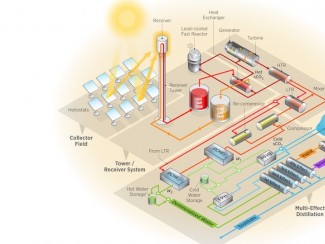When an earthquake and tsunami struck the Fukushima Daiichi nuclear plant complex in 2011, neither the quake nor the inundation caused the ensuing contamination. Rather, it was the aftereffects — specifically, the lack of cooling for the reactor cores, due to a shutdown of all power at the station — that caused most of the harm.
A new design for nuclear plants built on floating platforms, modeled after those used for offshore oil drilling, could help avoid such consequences in the future. Such floating plants would be designed to be automatically cooled by the surrounding seawater in a worst-case scenario, which would indefinitely prevent any melting of fuel rods, or escape of radioactive material.
The concept is being presented this week at the Small Modular Reactors Symposium, hosted by the American Society of Mechanical Engineers, by MIT professors Jacopo Buongiorno, Michael Golay, and Neil Todreas, along with others from MIT, the University of Wisconsin, and Chicago Bridge and Iron, a major nuclear plant and offshore platform construction company.
Such plants, Buongiorno explains, could be built in a shipyard, then towed to their destinations five to seven miles offshore, where they would be moored to the seafloor and connected to land by an underwater electric transmission line. The concept takes advantage of two mature technologies: light-water nuclear reactors and offshore oil and gas drilling platforms. Using established designs minimizes technological risks, says Buongiorno, an associate professor of nuclear science and engineering (NSE) at MIT.




